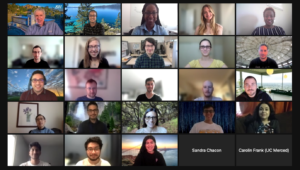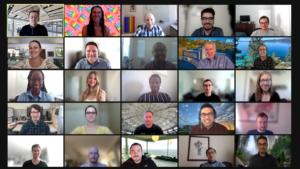Greetings my esteemed reader, you’re reading this because either you are serendipitously here by accident or else are interested in participating in the famous JGI-UC Merced internship program. You might not be sure if this internship is for you … Well, that’s why I am here, documenting my experience so that you can take a glimpse into what we interns were involved with.
Strap yourself in as you and I explore this past summer together. (Before we begin, take a few deep breaths and visualize yourself stepping into my shoes, so that “I” means you too.) Here we go!
It’s early March, the time of the year that the acerbic winter in the Central Valley begins to noticeably subside as spring comes in full force. It’s the early morning, the melancholic sun rising through the canopy of my bedroom shades. As is usual, I begin my morning routine of sifting through the insurmountable amount of school emails, but if I don’t get through them now, I never will. As I finish, I realize I accidentally deleted something that looked interesting, an email about a summer internship at the Joint Genome Institute. I pause and contemplate my compatibility with the program as a 2nd year Physics Ph.D. student. Why not? I’ll apply; surely I could learn skills that could apply to my own research.
It’s Spring 2021 and I’ve been selected for the Internship. I’ll be working on examining the role that environmental factors play in the evolution of mitochondria, the energy machines in our cells. My background is in physics, so I have experience in programming and modeling, skills needed for this project. However, it would take a fair amount of studying to learn the fundamentals needed. An uphill journey, certainly, but not impossible.
Before beginning work on projects, all interns were required to complete training on essential programming tools in June. Here on the right is a group photo of us at the beginning of the program. We had no idea what was awaiting us because the first week of training went by rapidly and gave the sense that we could accomplish anything.
After our week of training, I met my mentors for the internship, Frederik Schulz and Juan Villada, two out-of-this-world researchers. It was during the first meeting that the challenges of not being a biology major arose: the plethora of terminology not used in my area of study. This, at least, had a simple solution of sifting through the genomics literature to understand the new vocabulary needed for this kind of research.

My first day on the job was interesting. I remember thinking, “What in the world is a Fasta file and how do I work it?” I later learned it was simply a formatting style for storing genetic sequences. My first attempt at working with Fasta was to use the increasingly popular programming language Julia. As it turned out, this language is not yet suited for this type of task for a litany of reasons, one of them being that the most maintained software is in Python. So, I began living and breathing in Python.
I had thought that the hardest part was grappling with the vocabulary only to realize I had a new, different uphill battle waiting. I quickly learned that when using open source software, documentation is key. Due to the nature of cutting-edge software, sometimes the documentation, when it is available, could be out of date because significant modifications to the codes were made. All of this, I learned, can lead to spurious results.
Before starting this internship program, I had gathered ample experience working with multiple programming languages, however, this was the first time that I wasn’t writing algorithms from scratch. Fortunately, I learned that there is a fairly simple solution: read copious amounts of documentation to better understand what the software is doing, and repeat again and again.
As the summer continued, I began to get the hang of things and understood how to work with all the tools. At the end of the internship, we constructed an evolutionary tree for our sample organisms and discovered potentially new, previously unclassified mitochondria. Beyond the impact this may have in the research field, it reinforced one lesson — documentation is key.
But jokes aside, this internship was fun, especially waking up early to meet with my mentors? and learning how to analyze genetic sequence data, extract conserved genes, and reconstruct phylogenies. While I can’t physically take anything back with me to my university as memorabilia, I gained an appreciation for studies in genetics, discovered essential tools that can be applied to my Ph.D. research, and most importantly, networked with new collaborators.
So, is this the Internship program for you? Should you talk to your professor after reading this blog to ask for letters of recommendation? Should you apply? I think we know the answer to that…do it!
Written by: Jimmy Gonzalez Nunez
Nunez is a 2nd Year Physics Ph.D Student at the University of California, Merced.


